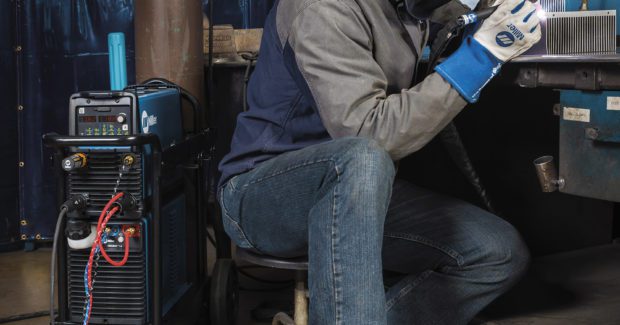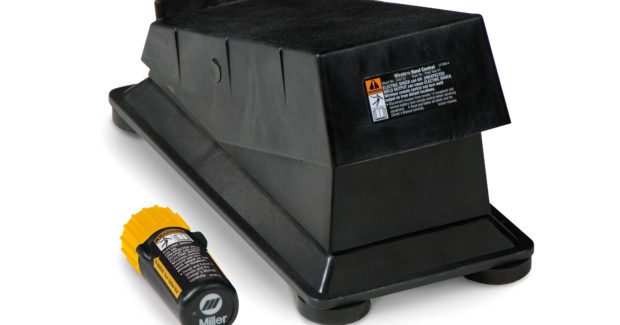How Wireless Foot Controls Improve Productivity and Quality in TIG Welding
Even small improvements in production can add up over time. Wireless foot controls offer a return on investment by helping to improve productivity and efficiency in TIG welding operations and eliminating the time and money spent on control cord repairs and failure, reducing weld clutter in the work space, and improving operator comfort and mobility.
Posted: October 28, 2016
Welding operators are often restricted by the length and cumbersome nature of the cords and leads required to lay a weld with their TIG torch. These elements slow movement around weld cells, clutter the floor, and create impediments to safety and productivity. Operator comfort is a key part of success in TIG welding that results in better maneuverability and can lead to improved productivity and, ultimately, better weld quality. One technology that eliminates or reduces these restrictions to improve welding operator comfort and control is wireless TIG foot controls, which help reduce operational and labor costs and provide numerous quality, productivity and safety benefits.
CHALLENGES IMPACTING WELDING PERFORMANCE
Foot pedals are commonly used to control amperage during TIG welding. However, traditional corded foot pedals can limit operator mobility, result in more clutter in the work area, and become a common source of downtime for repairs that are required when cords become damaged. There are several common challenges that can occur when using a corded foot pedal in TIG welding. In order to maintain flexibility, foot control cords are relatively thin, making it easy for them to be damaged in the work space. For example, cords can be damaged by sharp edges on tables, benches, stools . . . even the workpiece itself. Damage can occur when the cord is dragged across these edges during repositioning, or when a heavy work table or supply cart rolls over the cord. Contact with hot parts in the welding cell, such as recently completed welds or the nozzle of the TIG torch, is also a frequent cause of cord damage.
Damage to the foot control cord can result in a loss of connection, meaning the welding operator no longer has control via the foot pedal. This can cause downtime and increased costs for repair, or even require the replacement of the entire remote unit. Cord repair and replacement costs can add up to hundreds of dollars over the life of the product. In addition, more cords being used in the welding operation means greater clutter in the work space and the potential for cord tangling. Using a corded foot pedal means there are three cords necessary – the pedal, the work lead and the TIG torch cord – for each machine. Not only can these cords pose potential trip and fall hazards for operators, they can also result in increased frustration with untangling and time spent on cord management. Reducing the time spent winding and unwinding cords each day can improve productivity and efficiency.
CONSIDER A WIRELESS SOLUTION
Because of all these issues, cord care and management can be a time-consuming and costly issue for welding shops. Wireless foot controls provide a solution to all of this. Wireless foot pedals have a transmitter in the base of the control that communicates with the receiver on the front of the power source. Wireless foot pedals operate in the same manner as traditional wired foot pedals, the only difference is they do not require a control cord. Eliminating the need for a foot pedal control cord offers numerous benefits, including:
- Less downtime and money is spent on cord repair and maintenance.
- Operators save time they would otherwise spend untangling, winding and unwinding the control cord – often up to 10 minutes to 15 minutes daily, or over 50 hours per year.
- Clutter in the work area is reduced, which in turn lessens the opportunity for trip or fall injuries.
Eliminating the need for the control cord also helps improve welding operator comfort by eliminating the need for awkward positioning to reach the workpiece and/or the maneuvering involved with too short of a cord. As with any wireless technology, there are some limitations to the foot controls for TIG welding. For example, when welding takes place inside a metal enclosure, such as a boiler pressure vessel or the hull of a ship, the wireless signal may not transmit well if there is not a large enough opening for the signal to travel through. Wireless technology works best when the spot of the weld is kept relatively within the line of sight of the power source. Under these conditions, some wireless foot controls can work up to a 90 ft from the power source, although with TIG welding, distance is often limited by the length of the TIG torch cable.
Steps to overcome these line-of-sight issues and still reap the benefits of having wireless control at the point of the weld include using a 14-pin control cord extension that expands the reach of the wireless receiver while still providing mobility and point-of-use control in the immediate welding environment.
There are some additional considerations when choosing wireless foot controls: Some manufacturers offer remote foot controls that use standard batteries that are easy to change without the need for tools. Look for these options to simplify battery changeover and reduce costs. Also consider choosing wireless foot controls that are designed to prevent signal interference and that can be automatically paired with the machine and stays paired with the same unit until paired with another receiver. This automatic capability allows users to easily pair a foot pedal with their machine even if they are not sure which control it was paired to before – even when many wireless foot controls and machines are being used in the work space.
REAP THE BENEFITS OF WIRELESS FOOT CONTROL
Even small improvements in production can add up over time. Wireless foot controls offer a return on investment by helping to improve productivity and efficiency in TIG welding operations and eliminating the time and money spent on control cord repairs and failure, reducing weld clutter in the work space, and improving operator comfort and mobility.






